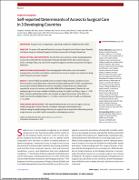| dc.contributor.author | Forrester, Joseph D | |
| dc.contributor.author | Forrester, Jared A | |
| dc.contributor.author | Kamara, Thaim B | |
| dc.contributor.author | Groen, Reinou S | |
| dc.contributor.author | Shrestha, Sunil | |
| dc.contributor.author | Gupta, Shailvi | |
| dc.contributor.author | Kyamanywa, Patrick | |
| dc.contributor.author | Petroze, Robin T | |
| dc.contributor.author | Kushner, Adam L | |
| dc.contributor.author | Wren, Sherry M | |
| dc.date.accessioned | 2022-04-19T08:11:57Z | |
| dc.date.available | 2022-04-19T08:11:57Z | |
| dc.date.issued | 2016 | |
| dc.identifier.citation | Forrester, J.D., Forrester, J.A., Kamara, T.B., Groen, R.S., Shrestha, S., Gupta, S., Kyamanywa, P., Petroze, R.T., Kushner, A.L. and Wren, S.M. (2016). Self-reported determinants of access to surgical care in 3 developing countries. JAMA surgery, 151(3), pp.257-263. | en_US |
| dc.identifier.issn | 2168-6254 / 2168-6262 | |
| dc.identifier.uri | http://hdl.handle.net/20.500.12280/2950 | |
| dc.description.abstract | IMPORTANCE Surgical care is recognized as a growing component of global public health.
OBJECTIVE To assess self-reported barriers to access of surgical care in Sierra Leone, Rwanda,
and Nepal using the validated Surgeons OverSeas Assessment of Surgical Need tool.
DESIGN, SETTING, AND PARTICIPANTS Data for this cross-sectional, cluster-based population
survey were collected from households in Rwanda (October 2011), Sierra Leone (January
2012), and Nepal (May and June 2014) using the Surgeons OverSeas Assessment of Surgical
Need tool.
MAIN OUTCOMES AND MEASURES Basic demographic information, cost and mode of
transportation to health care facilities, and barriers to access to surgical care of persons dying
within the past year were analyzed.
RESULTS A total of 4822 households were surveyed in Nepal, Rwanda, and Sierra Leone.
Primary health care facilities were commonly reached rapidly by foot (>70%), transportation
to secondary facilities differed by country, and public transportation was ubiquitously
required for access to a tertiary care facility (46%-82% of respondents). Reasons for not
seeking surgical care when needed included no money for health care (Sierra Leone: n = 103;
55%), a person dying before health care could be arranged (all countries: 32%-43%), no
health care facility available (Nepal: n = 11; 42%), and a lack of trust in health care (Rwanda:
n = 6; 26%).
CONCLUSIONS AND RELEVANCE Self-reported determinants of access to surgical care vary
widely among Sierra Leone, Rwanda, and Nepal, although commonalities exist.
Understanding the epidemiology of barriers to surgical care is essential to effectively provide
surgical service as a public health commodity in developing countries. | en_US |
| dc.language.iso | en | en_US |
| dc.publisher | Amer Medical Assoc , 330 N Wabash Ave, Ste 39300, Chicago, Usa, Il, 60611-5885 | en_US |
| dc.relation.ispartofseries | JAMA surgery;151(3) | |
| dc.subject | Surgical care | en_US |
| dc.subject | Developing countries | en_US |
| dc.subject | Access to care | en_US |
| dc.title | Self-reported Determinants of Access to Surgical Care in 3 Developing Countries | en_US |
| dc.type | Article | en_US |


